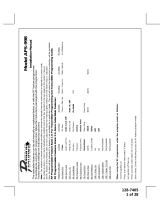
128-9312
14 of 24
14
DIESEL ENGINE SETTINGS:
NOTE: When selecting Diesel operation, (Bank 3 Feature #12), over gasoline, the only change is to the
ignition circuits. When Diesel is selected, the ignition circuits will power up 10, 15, or 20 seconds
before the start circuit. The intent of this feature is to allow the glow plug warming required by some
diesel engines. If your vehicle is a instant start diesel, it is not necessary to activate this feature.
ALSO: When selecting Diesel mode, be certain that the intended vehicle has a true tach reference and
be certain to connect the tach input wire. Also note, if the "Diesel Wait to Start" input is connected,
(Green/Yellow) this wire will take precedence over the Diesel selection of Bank 3 feature 12.
4 PIN IN VEHICLE DATA BUS PORT (DBI Port) (Connector Port)
The 4 pin port located on the side of this module is for proprietary data bus interface modules. These modules
are used to access a variety of features in the vehicle which can be as simple as door trigger inputs, to more
complex door locks outputs, or transponder interfaces for remote starting. DO NOT connect anything to this
port other than the Audiovox IDB modules or damage to the Remote Start module will occur. All installation
instructions for the IDB modules will be packaged with the individual component along with the proper 4 pin
wiring harness requires to access the data transmit & receive as well as the proper voltage levels for the
interface.
Monitoring The Vehicle's Engine: (Program Bank 3, Feature 5)
There are 4 ways that the remote start monitors the engine running, one or the other must be selected for
your application for the remote start to operate correctly.
1) VOLTAGE SENSE SETTING:
The unit will monitor the voltage level of the battery during remote start, wait for the voltage to drop while
cranking, then look for the voltage level to go above the level it was before the vehicle began to crank which
indicates the vehicle is running. Feature #14 of Bank 3 must be set for averaging or the voltage sense feature
will not operate indicated by the parking lights ashing 7 times.
2) TACH RATE SETTING:
1. Turn the ignition key to the On position.
2. Press and release the valet/program push button switch 3 times.
3. Immediately turn the ignition key Off.
4. Press and hold the valet/program push button switch, then start the vehicle using the key.
5. When the unit senses the tach signal, the parking lights will begin to ash.
6. Release the valet/program pushbutton switch. The parking lights will turn on for three seconds to indicate
that the learned tach signal is stored and the unit is out of the tach learn mode.
NOTE: If the unit fails to learn tach rate due to an improper tachometer connection or a poor tach source,
the parking lights will not ash. To correct this situation, locate and connect the Green/Orange Wire
to the proper tach signal, and then repeat the tach learn routine.
3) DBI TACH SETTING:
Selecting this setting in the option menu indicates that you have a DBI module and have determined that a
tach signal is available for the vehicle you are connecting to. The unit will look at the DBI data port for the
tach signal. If the vehicle fails to start, or the unit ashes 7 times, recheck the DBI manual to insure that tach
is available for your vehicle. If not the tach connection wire, Green/Orange must be used.
4) HYBRID SETTING:
Selecting this setting in the option menu allows for Hybrid vehicles. Also feature #14 of Bank 3 must be set
for preset or the Hybrid feature will not operate indicated by the parking lights ashing 7 times.
CRANK AVERAGING:
When Feature 14 Bank 3 is set for crank averaging, the remote start unit constantly monitors and learns the
cranking patterns of the vehicle each time the car is started with the key. The vehicle must be started at least
4 times with the key for the crank averaging circuit to begin monitoring the vehicle's engine.





















